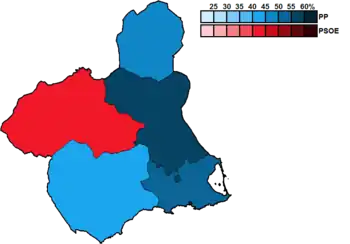1995 Murcian regional election
The 1995 Murcian regional election was held on Sunday, 28 May 1995, to elect the 4th Regional Assembly of the autonomous community of the Region of Murcia. All 45 seats in the Regional Assembly were up for election. The election was held simultaneously with regional elections in twelve other autonomous communities and local elections all throughout Spain.
| |||||||||||||||||||||||||||||||||||||||||||||
All 45 seats in the Regional Assembly of Murcia 23 seats needed for a majority | |||||||||||||||||||||||||||||||||||||||||||||
|---|---|---|---|---|---|---|---|---|---|---|---|---|---|---|---|---|---|---|---|---|---|---|---|---|---|---|---|---|---|---|---|---|---|---|---|---|---|---|---|---|---|---|---|---|---|
| Opinion polls | |||||||||||||||||||||||||||||||||||||||||||||
| Registered | 847,967 | ||||||||||||||||||||||||||||||||||||||||||||
| Turnout | 638,297 (75.3%) | ||||||||||||||||||||||||||||||||||||||||||||
| |||||||||||||||||||||||||||||||||||||||||||||
 Constituency results map for the Regional Assembly of Murcia | |||||||||||||||||||||||||||||||||||||||||||||
| |||||||||||||||||||||||||||||||||||||||||||||
Former president Carlos Collado had been formed to resign in April 1993 by his own party, the Spanish Socialist Workers' Party (PSOE), as a result of the ongoing struggle between the guerristas and renovadores factions within the PSOE and a political scandal over the purchase of the Casa Grande estate.[1][2] He was replaced by María Antonia Martínez, the first woman presiding over a Spanish autonomous community as well as the only one to date holding the office in the Region of Murcia.[3] The crisis resulting in Collado's resignation was among the factors said to contribute to the opposition People's Party (PP) spectacular gains in that year's June general election, overcoming the PSOE as the most voted party in the region for the first time in democracy;[4] a feat which was confirmed in the 1994 European Parliament election.[5][6]
The regional election resulted in the PP consolidating its gains, winning by a landslide as the vote for the ruling PSOE plummeted.[7] PP leader Ramón Luis Valcárcel would become the new President of the Region of Murcia,[8] with the PP remaining in government ever since. The PP would also remain the prime party of Murcian politics until 2019.
Overview
Electoral system
The Regional Assembly of Murcia was the devolved, unicameral legislature of the autonomous community of Murcia, having legislative power in regional matters as defined by the Spanish Constitution and the Murcian Statute of Autonomy, as well as the ability to vote confidence in or withdraw it from a President of the Region.[9] Voting for the Regional Assembly was on the basis of universal suffrage, which comprised all nationals over eighteen, registered in the Region of Murcia and in full enjoyment of their political rights.
The 45 members of the Regional Assembly of Murcia were elected using the D'Hondt method and a closed list proportional representation, with a threshold of 5 percent of valid votes—which included blank ballots—being applied regionally. Parties not reaching the threshold were not taken into consideration for seat distribution. Seats were allocated to constituencies, which were established by law as follows:
- I–Lorca (comprising the municipalities of Lorca, Aguilas, Puerto Lumbreras, Totana, Alhama de Murcia, Librilla, Aledo and Mazarrón).
- II–Cartagena (comprising the municipalities of Cartagena, La Unión, Fuente Alamo de Murcia, Torre-Pacheco, San Javier, San Pedro del Pinatar and Los Alcázares).
- III–Murcia (comprising the municipalities of Murcia, Alcantarilla, Beniel, Molina de Segura, Alguazas, Las Torres de Cotillas, Lorquí, Ceutí, Cieza, Abarán, Blanca, Archena, Ricote, Ulea, Villanueva del Río Segura, Ojós, Fortuna, Abanilla and Santomera).
- IV–Northwest (comprising the municipalities of Caravaca, Cehegín, Calasparra, Moratalla, Bullas, Pliego, Mula, Albudeite and Campos del Río).
- V–Plateau (comprising the municipalities of Yecla and Jumilla).
Each constituency was entitled to an initial minimum of one seat, with the remaining 40 allocated among the constituencies in proportion to their populations.[10]
The electoral law provided that parties, federations, coalitions and groupings of electors were allowed to present lists of candidates. However, groupings of electors were required to secure the signature of at least 1 percent of the electors registered in the constituency for which they sought election. Electors were barred from signing for more than one list of candidates. Concurrently, parties and federations intending to enter in coalition to take part jointly at an election were required to inform the relevant Electoral Commission within ten days of the election being called.[10][11][12]
Election date
The term of the Regional Assembly of Murcia expired four years after the date of its previous election. Elections to the Regional Assembly were fixed for the fourth Sunday of May every four years. The previous election was held on 26 May 1991, setting the election date for the Regional Assembly on Sunday, 28 May 1995.[9][10][11][12]
The Regional Assembly of Murcia could not be dissolved before the date of expiry of parliament except in the event of an investiture process failing to elect a regional President within a two-month period from the first ballot. In such a case, the Regional Assembly was to be automatically dissolved and a snap election called, with elected deputies merely serving out what remained of their four-year terms.[9]
Opinion polls
The table below lists voting intention estimates in reverse chronological order, showing the most recent first and using the dates when the survey fieldwork was done, as opposed to the date of publication. Where the fieldwork dates are unknown, the date of publication is given instead. The highest percentage figure in each polling survey is displayed with its background shaded in the leading party's colour. If a tie ensues, this is applied to the figures with the highest percentages. The "Lead" column on the right shows the percentage-point difference between the parties with the highest percentages in a given poll. When available, seat projections are also displayed below the voting estimates in a smaller font. 23 seats were required for an absolute majority in the Regional Assembly of Murcia.
- Color key:
Exit poll
| Polling firm/Commissioner | Fieldwork date | Sample size | Turnout | Lead | |||
|---|---|---|---|---|---|---|---|
| 1995 regional election | 28 May 1995 | N/A | 76.0 | 31.7 15 |
52.3 26 |
12.5 4 |
20.6 |
| Eco Consulting/RTVE[p 1][p 2] | 28 May 1995 | ? | ? | 29.9 14/16 |
50.9 23/26 |
14.8 5/6 |
21.0 |
| Demoscopia/El País[p 3][p 4][p 5] | 10–15 May 1995 | 800 | ? | 28.2 13 |
54.3 28 |
12.9 4 |
26.1 |
| CIS[p 6][p 7] | 24 Apr–10 May 1995 | 500 | 72.4 | 28.6 | 57.4 | 11.1 | 28.8 |
| 1994 EP election | 12 Jun 1994 | N/A | 66.5 | 31.0 | 52.2 | 13.1 | 21.2 |
| 1993 general election | 6 Jun 1993 | N/A | 81.6 | 38.6 | 47.3 | 9.7 | 8.7 |
| 1991 regional election | 26 May 1991 | N/A | 67.2 | 45.3 24 |
33.5 17 |
10.2 4 |
11.8 |
Results
Overall
 | ||||||
| Parties and coalitions | Popular vote | Seats | ||||
|---|---|---|---|---|---|---|
| Votes | % | ±pp | Total | +/− | ||
| People's Party (PP) | 330,514 | 52.23 | +18.72 | 26 | +9 | |
| Spanish Socialist Workers' Party (PSOE) | 201,659 | 31.87 | –13.40 | 15 | –9 | |
| United Left–The Greens of the Region of Murcia (IU–LV–RM)1 | 78,875 | 12.46 | +1.14 | 4 | ±0 | |
| Centrist Union–Democratic and Social Centre (UC–CDS) | 4,359 | 0.69 | –4.32 | 0 | ±0 | |
| Cantonal Party (PCAN) | 3,544 | 0.56 | –2.47 | 0 | ±0 | |
| Regional Murcianist Party (PMR) | 2,456 | 0.39 | New | 0 | ±0 | |
| Democratic Bloc (BD) | 1,601 | 0.25 | New | 0 | ±0 | |
| Spanish Confederation of Independents (CEDI) | 1,454 | 0.23 | New | 0 | ±0 | |
| New Region (NR) | 1,336 | 0.21 | New | 0 | ±0 | |
| Blank ballots | 7,033 | 1.11 | +0.17 | |||
| Total | 632,831 | 45 | ±0 | |||
| Valid votes | 632,831 | 99.14 | +0.10 | |||
| Invalid votes | 5,466 | 0.86 | –0.10 | |||
| Votes cast / turnout | 638,297 | 75.27 | +8.09 | |||
| Abstentions | 209,670 | 24.73 | –8.09 | |||
| Registered voters | 847,967 | |||||
| Sources[13][14][15] | ||||||
Aftermath
| Investiture Ramón Luis Valcárcel (PP) | ||
| Ballot → | 30 June 1995 | |
|---|---|---|
| Required majority → | 23 out of 45 | |
Yes
|
26 / 45 | |
19 / 45 | ||
| Abstentions | 0 / 45 | |
| Absentees | 0 / 45 | |
| Sources[8][15] | ||
References
- Opinion poll sources
- "El PP se impuso en diez comunidades". Diario de Navarra (in Spanish). 29 May 1995.
- "Valcárcel, del PP, vence a la guerrista Martínez". ABC (in Spanish). 29 May 1995.
- "El PP será la fuerza más votada en 12 comunidades". El País (in Spanish). 20 May 1995.
- "Mañana, previsiones para las municipales". El País (in Spanish). 20 May 1995.
- "El PP gana en doce autonomías y el PSOE sólo en Extremadura, según un sondeo". La Vanguardia (in Spanish). 21 May 1995.
- "Preelectoral Comunidad Autónoma de Murcia (Estudio 2169. Abril-Mayo 1995)". CIS (in Spanish). 10 May 1995.
- "Estudio CIS nº 2169. Ficha técnica" (PDF). CIS (in Spanish). 10 May 1995.
- Other
- "El presidente de Murcia, atacado por su partido". El País (in Spanish). 15 April 1993. Retrieved 10 December 2019.
- "Carlos Collado: "Me sentí traicionado y apuñalado por mis propios compañeros, y el PSOE no ha repuesto mi honor"". Cadena SER (in Spanish). 24 February 2017. Retrieved 10 December 2019.
- "María Antonia Martínez, elegida presidenta de la autonomía murciana". El País (in Spanish). 28 April 1993. Retrieved 10 December 2019.
- "MURCIA: El PP supera por primera vez al PSOE". El País (in Spanish). 8 June 1993. Retrieved 10 December 2019.
- "El PP se adueña del mapa electoral". El País (in Spanish). 14 June 1994. Retrieved 10 December 2019.
- "Segundo castigo y cambio de presidente". El País (in Spanish). 30 May 1995. Retrieved 10 December 2019.
- "El PP da un vuelco al mapa autonómico y municipal". El País (in Spanish). 29 May 1995. Retrieved 10 December 2019.
- "El popular Valcarcel, presidente con mayoría absoluta". El País (in Spanish). 1 July 1995. Retrieved 10 December 2019.
- "Statute of Autonomy for the Region of Murcia of 1982". Organic Law No. 4 of 9 June 1982. Official State Gazette (in Spanish). Retrieved 22 February 2017.
- "Region of Murcia Electoral Law of 1987". Law No. 2 of 24 February 1987. Official Gazette of the Region of Murcia (in Spanish). Retrieved 22 February 2017.
- "General Electoral System Organic Law of 1985". Organic Law No. 5 of 19 June 1985. Official State Gazette (in Spanish). Retrieved 28 December 2016.
- "Representation of the people Institutional Act". www.juntaelectoralcentral.es. Central Electoral Commission. Retrieved 16 June 2017.
- "Regional Assembly of Murcia election results, 28 May 1995" (PDF). www.juntaelectoralcentral.es (in Spanish). Electoral Commission of Murcia. 21 November 1995. Retrieved 30 September 2017.
- Sierra Rodríguez, Javier (2015). El Sistema Electoral de la Región de Murcia: Balance y Perspectivas (PDF) (in Spanish). Murcia: Universidad de Murcia. Facultad de Derecho. p. 322. Retrieved 6 December 2019.
- "Elecciones a la Asamblea Regional de Murcia (1983 - 2019)". Historia Electoral.com (in Spanish). Retrieved 30 September 2017.
.jpg.webp)
